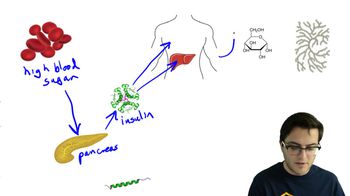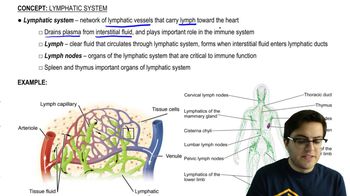Table of contents
- 1. Introduction to Biology2h 42m
- 2. Chemistry3h 37m
- 3. Water1h 26m
- 4. Biomolecules2h 23m
- 5. Cell Components2h 26m
- 6. The Membrane2h 31m
- 7. Energy and Metabolism2h 0m
- 8. Respiration2h 40m
- 9. Photosynthesis2h 49m
- 10. Cell Signaling59m
- 11. Cell Division2h 47m
- 12. Meiosis2h 0m
- 13. Mendelian Genetics4h 44m
- Introduction to Mendel's Experiments7m
- Genotype vs. Phenotype17m
- Punnett Squares13m
- Mendel's Experiments26m
- Mendel's Laws18m
- Monohybrid Crosses19m
- Test Crosses14m
- Dihybrid Crosses20m
- Punnett Square Probability26m
- Incomplete Dominance vs. Codominance20m
- Epistasis7m
- Non-Mendelian Genetics12m
- Pedigrees6m
- Autosomal Inheritance21m
- Sex-Linked Inheritance43m
- X-Inactivation9m
- 14. DNA Synthesis2h 27m
- 15. Gene Expression3h 6m
- 16. Regulation of Expression3h 31m
- Introduction to Regulation of Gene Expression13m
- Prokaryotic Gene Regulation via Operons27m
- The Lac Operon21m
- Glucose's Impact on Lac Operon25m
- The Trp Operon20m
- Review of the Lac Operon & Trp Operon11m
- Introduction to Eukaryotic Gene Regulation9m
- Eukaryotic Chromatin Modifications16m
- Eukaryotic Transcriptional Control22m
- Eukaryotic Post-Transcriptional Regulation28m
- Eukaryotic Post-Translational Regulation13m
- 17. Viruses37m
- 18. Biotechnology2h 58m
- 19. Genomics17m
- 20. Development1h 5m
- 21. Evolution3h 1m
- 22. Evolution of Populations3h 53m
- 23. Speciation1h 37m
- 24. History of Life on Earth2h 6m
- 25. Phylogeny2h 31m
- 26. Prokaryotes4h 59m
- 27. Protists1h 12m
- 28. Plants1h 22m
- 29. Fungi36m
- 30. Overview of Animals34m
- 31. Invertebrates1h 2m
- 32. Vertebrates50m
- 33. Plant Anatomy1h 3m
- 34. Vascular Plant Transport1h 2m
- 35. Soil37m
- 36. Plant Reproduction47m
- 37. Plant Sensation and Response1h 9m
- 38. Animal Form and Function1h 19m
- 39. Digestive System1h 10m
- 40. Circulatory System1h 49m
- 41. Immune System1h 12m
- 42. Osmoregulation and Excretion50m
- 43. Endocrine System1h 4m
- 44. Animal Reproduction1h 2m
- 45. Nervous System1h 55m
- 46. Sensory Systems46m
- 47. Muscle Systems23m
- 48. Ecology3h 11m
- Introduction to Ecology20m
- Biogeography14m
- Earth's Climate Patterns50m
- Introduction to Terrestrial Biomes10m
- Terrestrial Biomes: Near Equator13m
- Terrestrial Biomes: Temperate Regions10m
- Terrestrial Biomes: Northern Regions15m
- Introduction to Aquatic Biomes27m
- Freshwater Aquatic Biomes14m
- Marine Aquatic Biomes13m
- 49. Animal Behavior28m
- 50. Population Ecology3h 41m
- Introduction to Population Ecology28m
- Population Sampling Methods23m
- Life History12m
- Population Demography17m
- Factors Limiting Population Growth14m
- Introduction to Population Growth Models22m
- Linear Population Growth6m
- Exponential Population Growth29m
- Logistic Population Growth32m
- r/K Selection10m
- The Human Population22m
- 51. Community Ecology2h 46m
- Introduction to Community Ecology2m
- Introduction to Community Interactions9m
- Community Interactions: Competition (-/-)38m
- Community Interactions: Exploitation (+/-)23m
- Community Interactions: Mutualism (+/+) & Commensalism (+/0)9m
- Community Structure35m
- Community Dynamics26m
- Geographic Impact on Communities21m
- 52. Ecosystems2h 36m
- 53. Conservation Biology24m
40. Circulatory System
Heart Physiology
Problem 2
Textbook Question
Blood pressure is highest in _________ , and blood moves most slowly in _________ .
a. Veins; capillaries
b. Arteries; capillaries
c. Veins; arteries
d. Arteries; veins
 Verified step by step guidance
Verified step by step guidance1
Understand the structure of the circulatory system: Blood flows through arteries, capillaries, and veins in a closed loop. Arteries carry blood away from the heart, capillaries are the site of exchange between blood and tissues, and veins return blood to the heart.
Recall the relationship between blood pressure and blood vessel type: Blood pressure is highest in arteries because they are closest to the heart and receive blood directly from it. The pressure decreases as blood moves through the circulatory system.
Consider the speed of blood flow: Blood moves most slowly in capillaries because they have the smallest diameter and the largest total cross-sectional area, which allows for efficient exchange of gases, nutrients, and waste products.
Eliminate incorrect options: Veins do not have the highest blood pressure, and blood does not move most slowly in arteries or veins. This rules out options a, c, and d.
Select the correct answer: Based on the above reasoning, blood pressure is highest in arteries, and blood moves most slowly in capillaries. The correct answer is b.
 Verified video answer for a similar problem:
Verified video answer for a similar problem:This video solution was recommended by our tutors as helpful for the problem above
Video duration:
1mPlay a video:
Was this helpful?
Key Concepts
Here are the essential concepts you must grasp in order to answer the question correctly.
Blood Pressure
Blood pressure is the force exerted by circulating blood on the walls of blood vessels. It is highest in the arteries, particularly during systole when the heart contracts and pumps blood into the arterial system. Understanding blood pressure is crucial for comprehending how blood flows through the circulatory system and how it varies in different types of blood vessels.
Recommended video:
Guided course

Blood Pressure
Blood Vessels
Blood vessels are the conduits through which blood flows in the body, including arteries, veins, and capillaries. Arteries carry oxygen-rich blood away from the heart under high pressure, while veins return oxygen-poor blood back to the heart. Capillaries, the smallest blood vessels, facilitate the exchange of oxygen, carbon dioxide, nutrients, and waste between blood and tissues, which is why blood moves most slowly in them.
Recommended video:
Guided course

Blood Sugar Homeostasis
Circulatory System
The circulatory system is responsible for transporting blood, nutrients, gases, and waste products throughout the body. It consists of the heart, blood vessels, and blood. The system operates in a closed loop, with arteries carrying blood away from the heart and veins returning it, while capillaries serve as the site of exchange, highlighting the importance of understanding the flow dynamics in different vessel types.
Recommended video:
Guided course

Lymphatic System
Related Videos
Related Practice
Multiple Choice
Your blood pressure is 120/70. The "120" indicates __________, and the "70" indicates __________.
1198
views
1
rank


